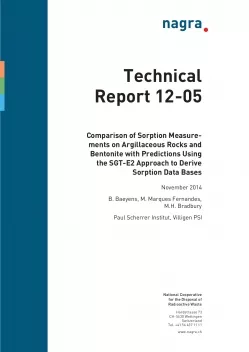
Technical Report NTB 12-05
Comparison of Sorption Measurements on Argillaceous Rocks and Bentonite with Predictions Using the SGT-E2 Approach to Derive Sorption Data Bases
In Stage 1 of the Sectoral Plan for Deep Geological Repositories, four rock types have been identified as being suitable host rocks for a radioactive waste repository, namely, Opalinus Clay for a high-level (HLW) and a low- and intermediate-level (L/ILW) repository, and 'Brauner Dogger', Effingen Member and Helvetic Marls for a L/ILW repository. Sorption data bases (SDBs) for all of these host rocks are required for the provisional safety analyses, including all of the bounding porewater and mineralogical composition combinations. In addition, SDBs are needed for the rock formations lying below Opalinus Clay (lower confining units) and for the bentonite backfill in the HLW repository.
A detailed procedure was developed for deriving SDBs for argillaceous rocks (and bentonite) based on sorption edge measurements on illite (and montmorillonite), the hypothesis that 2:1 clay minerals are the dominant sorbents and a series of so called conversion factors which take into account the different radionuclide speciations in the different porewaters.
Since this methodology for generating SDBs is relatively new, a validation and demonstration of the robustness and reliability of the sorption values derived was required. This report describes an extensive piece of work in which blind predictions of sorption values were compared with measured ones.
Sorption isotherms were measured for the following metal ions Cs(I), Co(II), Ni(II), Eu(III), Th(IV) and U(VI) in a range of realistic porewater chemistries for a range of host rock mineralogies. In the end 53 isotherm data sets were measured. For each of these isotherms a prediction was made of the sorption at trace concentrations using the SDB derivation methodology. A comparison between measured and predicted values for each case was then made.
This validation study shows that the methodology used for the derivation of the sorption data bases for argillaceous rocks and bentonite produces reliable sorption values.
